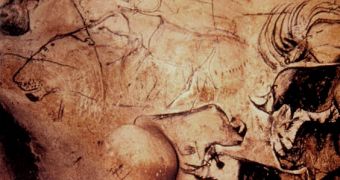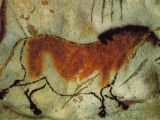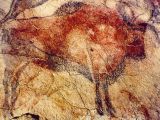The first Homo sapiens employed caves against the cold or the hot weather, or to shelter against rains and wild beasts. Even chimps in Senegal were found to use caves against heat and rain.
But what is more important is that caves have preserved many aspects of the life of the Paleolithic (Old Stone Age) people. Including their art. On their home caves' walls, the first artistic displays of the man emerged about 40,000 years ago, executed by Cro-Magnon people in Europe. This art faced the time and reached our times.
In the Ice Age western Europe, artists retreated deep into the grottoes, sometimes at tens of meters from the entrances, to paint or engrave on their walls and ceilings. Wall paintings dating from the Ice Age have been found in over 200 caves, of which 170 only in southern France and northern Spain.
The ancient people painted the large beasts they wanted to hunt for a better chance. Many of those animals disappeared but they still look at us on the cave paintings.
The first cave with wall paintings was found in Spain. In 1879, in Cantabria (northern Spain), at 30 km (18 mi) from Santander, the cave of Altamira was discovered. Inside, a complete skeleton of a cave bear and an Ice Age giant deer's bones (this was a deer as big as a bull living on tundras) were found. On the roof of one room paintings depicting wisents, wild horses and wild boars were discovered. A big shell served to the ancient painter as palette and the materials employed were ocher (hematite) and charcoal. All were dated 12,000 years old, in the Upper Paleolithic.
In 1940, the Lascaux cave system (south-central France) was discovered in France. The paintings from Lascaux are 16,000 years old (during the last glaciation, Wurm) and depict wild horses, aurochs (wild cattle), bears, wisents, reindeer and giant deers. Because of the style, size and amplitude, Lascaux was called the Sistine Chapel of the prehistory. Dominant themes are the couples horse-aurochs and horse-wisent (355 horses and 87 wisents).
In nearby Montespan, 20,000 years old cave paintings of mammoths, horses, wisents, giant deer and hyenas were found. In one of its gallery, clay statuettes of bears and lions were discovered.
The third greatest discovery ever was made in 1994, in the cave of Chauvet (Vallon-Pont-d'Arc, France), a grotto adorned with painting and engravings made 31,000 years ago (during the Wurm glaciation, too), the oldest artistic sanctuary ever discovered.
Both in Lascaux and Chauvet, abstract figures accompany the more or less naturalistic representations. In the case of Chauvet, predatory or dangerous animals dominate, while in Lascaux the main representations are of large herbivorous mammals. In Chauvet, there are three times more mammoths and woolly rhinoceroses represented than in other caves, followed by lions, horses, aurochs, bears, reindeer, wisents and giant deer. The west European clime of those times resembled the current one in northern Europe, with less marked seasons and milder summers.
The Chauvet artists use the imprint (unique), achieving the perspective and movement effect, not found in any other painted cave. This is opposite to Lascaux, where there are no perspectives, landscapes or realistic effects. All is made following canons, it is almost an abstract art (if we except the fact that the animals represented were real).
Because both in Lascaux and Chover the paintings were made deep into the caves, the artists used torches and grease lamps. Only in Lascaux, researchers found 21 such lighting devices, made of pieces of limestone or grindstone, as wicks being used dry, likens or juniper sticks.
In 1959, researchers discovered in the Kapov's cave (southern Urals, Russia) 55 paintings of Ice Age mammals: mammoths, giant deer, steppe horses, bears, lions, woolly rhinoceros. In one room, the researchers even discovered the improvised scaffold employed by the ancient artist. The colorants employed were red and yellow ocher and charcoal.

 14 DAY TRIAL //
14 DAY TRIAL // 

